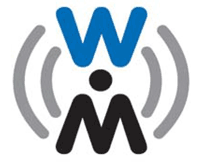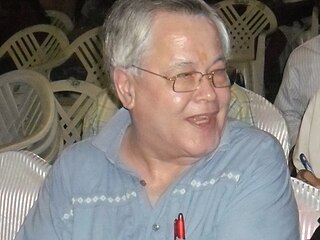Bluetooth is a short-range wireless technology standard that is used for exchanging data between fixed and mobile devices over short distances using UHF radio waves in the ISM bands, from 2.402 GHz to 2.48 GHz, and building personal area networks (PANs). It is not conceived as a wireless alternative to RS-232 data cables. It is mainly used as an alternative to wire connections, to exchange files between nearby portable devices and connect cell phones and music players with wireless headphones. In the most widely used mode, transmission power is limited to 2.5 milliwatts, giving it a very short range of up to 10 meters (30 feet).

The Bluetooth Special Interest Group is the standards organization that oversees the development of Bluetooth standards and the licensing of the Bluetooth technologies and trademarks to manufacturers. The SIG is a not-for-profit, non-stock corporation founded in September 1998. The SIG is headquartered in Kirkland, Washington.
IEEE 802.15 is a working group of the Institute of Electrical and Electronics Engineers (IEEE) IEEE 802 standards committee which specifies wireless personal area network (WPAN) standards. There are 10 major areas of development, not all of which are active.
In the seven-layer OSI model of computer networking, the physical layer or layer 1 is the first and lowest layer; The layer most closely associated with the physical connection between devices. This layer may be implemented by a PHY chip.

IEEE 802.20 or Mobile Broadband Wireless Access (MBWA) was a specification by the standard association of the Institute of Electrical and Electronics Engineers (IEEE) for mobile broadband networks. The main standard was published in 2008. MBWA is no longer being actively developed.

The Wi-Fi Alliance is a non-profit organization that owns the Wi-Fi trademark. Manufacturers may use the trademark to brand products certified for Wi-Fi interoperability.

Telematics is an interdisciplinary field that encompasses telecommunications, vehicular technologies, electrical engineering, and computer science. Telematics can involve any of the following:

IEEE 802.16 is a series of wireless broadband standards written by the Institute of Electrical and Electronics Engineers (IEEE). The IEEE Standards Board established a working group in 1999 to develop standards for broadband for wireless metropolitan area networks. The Workgroup is a unit of the IEEE 802 local area network and metropolitan area network standards committee.

Wireless USB was a short-range, high-bandwidth wireless radio communication protocol created by the Wireless USB Promoter Group which intended to increase the availability of general USB-based technologies. It is unrelated to Wi-Fi. It was maintained by the WiMedia Alliance which ceased operations in 2009. Wireless USB is sometimes abbreviated as "WUSB", although the USB Implementers Forum discouraged this practice and instead prefers to call the technology Certified Wireless USB to distinguish it from the competing UWB standard.

HomeRF was a wireless networking specification for home devices. It was developed in 1998 by the Home Radio Frequency Working Group, a consortium of mobile wireless companies that included Proxim Wireless, Intel, Siemens AG, Motorola, Philips and more than 100 other companies.
The Optical Internetworking Forum (OIF) is a prominent non-profit consortium that was founded in 1998. It promotes the development and deployment of interoperable computer networking products and services through implementation agreements (IAs) for optical networking products and component technologies including SerDes devices.
The EnOcean technology is an energy harvesting wireless technology used primarily in building automation systems, but also in other application fields such as industry, transportation, logistics or smart homes solutions. The energy harvestng wireless modules are manufactured and marketed by the company EnOcean, headquartered in Oberhaching near Munich. The modules combine micro energy converters with ultra low power electronics and wireless communications and enable batteryless, wireless sensors, switches, and controls.

The WiMedia Alliance was a non-profit industry trade group that promoted the adoption, regulation, standardization and multi-vendor interoperability of ultra-wideband (UWB) technologies. It existed from about 2002 through 2009.
Bluetooth Low Energy is a wireless personal area network technology designed and marketed by the Bluetooth Special Interest Group aimed at novel applications in the healthcare, fitness, beacons, security, and home entertainment industries. It is independent of classic Bluetooth and has no compatibility, but BR/EDR and LE can coexist. The original specification was developed by Nokia in 2006 under the name Wibree, which was integrated into Bluetooth 4.0 in December 2009 as Bluetooth Low Energy.

Victor "Vic" Hayes is a former Senior Research Fellow at the Delft University of Technology. His role in establishing and chairing the IEEE 802.11 Standards Working Group for Wireless Local Area Networks has led to him being referred to by some as the "Father of Wi-Fi".
WiGig, alternatively known as 60 GHz Wi-Fi, refers to a set of 60 GHz wireless network protocols. It includes the current IEEE 802.11ad standard and also the upcoming IEEE 802.11ay standard.

The OPEN Alliance is a non-profit, special interest group (SIG) of mainly automotive industry and technology providers collaborating to encourage wide scale adoption of Ethernet-based communication as the standard in automotive networking applications.
David Skellern is an Australian electronic engineer and computer scientist credited, along with colleagues, for the first chip-set implementation of the IEEE 802.11a wireless networking standard.

James Digby Yarlet Collier is a physicist and was Chief Technology Officer (CTO) of Neul Limited. Previously, he held several technical and executive positions at Cambridge Silicon Radio (CSR), UbiNetics, Cambridge Consultants and Schlumberger
Universal Electronics Inc. (UEI) is an American smart home technology provider and manufacturer of universal remote controls, IoT devices such as voice-enabled smart home hubs, smart thermostats, home sensors; as well as a white label digital assistant platform optimized for smart home applications, and other software and cloud services for device discovery, fingerprinting and interoperability. The company designs, develops, manufactures and ships products both under the "One For All" brand and as an OEM for other companies in the audio video, subscription broadcasting, connected home, tablet and smart phone markets. In 2015, it expanded its product and technology platform to include home automation, intelligent sensing and security.










